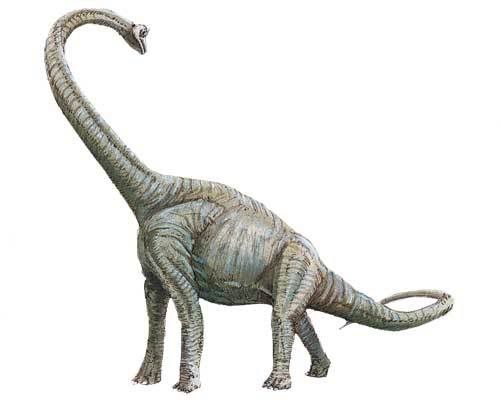Post by Barry the Baryonyx on Jul 6, 2007 14:54:36 GMT -5
Brachiosaurus

Image Copyright © 2005 Miles Kelly Publishing.
Brachiosaurus meaning "Arm Lizard", from the Greek brachion/meaning 'arm' and sauros/σαυρος meaning 'lizard', was a genus of sauropod dinosaur which lived during the Late Jurassic Period. It was thus named because its forelimbs were longer than its hind limbs. One of the largest animals ever to walk the earth, it has become one of the most famous of all dinosaurs and is widely recognised worldwide.
For many decades, Brachiosaurus was the largest dinosaur known. It has since been discovered that a number of giant titanosaurians (Argentinosaurus, for example) surpassed Brachiosaurus in terms of sheer mass. More recently, another brachiosaurid, Sauroposeidon, has also been discovered; based on incomplete fossil evidence, it too is likely to have outweighed Brachiosaurus.
Brachiosaurus is often considered to be the largest dinosaur known from a relatively complete fossilized skeleton. However, the most complete specimens, including the Brachiosaurus in the Humboldt Museum of Berlin (excavated in Africa, the tallest mounted skeleton in the world), are members of the species B. brancai which some scientists consider to be part of a separate genus, Giraffatitan. The holotype material of the type species, B. altithorax. includes a sequence of seven posterior dorsal vertebrae, sacrum, proximal caudal vertebra, coracoid, humerus, femur and ribs: enough from which to estimate size.
Based on a complete composite skeleton, Brachiosaurus attained 25 metres (82 feet) in length and was probably able to raise its head about 13 metres (42 ft) above ground level. Fragmentary material from larger specimens indicates that it could grow 15% longer than this. Such material includes an isolated fibula HMN XV2 1340 cm in length and the brachiosaurid scapulocoracoid referred to Ultrasauros.
Brachiosaurus has been estimated to have weighed anywhere between 15 tonnes (Russell et al., 1980) and 78 tonnes (Colbert, 1962). These extreme estimates can be discarded as that of Russell et al. was based on limb-bone allometry rather than a body model, and that of Colbert on an outdated and overweight model. More recent estimates based on models reconstructed from osteology and inferred musculature are in the range 32 tonnes (Paul 1988) to 37 tonnes (Christiansen 1997). The 15% longer specimens hinted at above would have massed 48 to 56 tonnes.
From Wikipedia, the free encyclopedia


 Is it just us?
Is it just us?